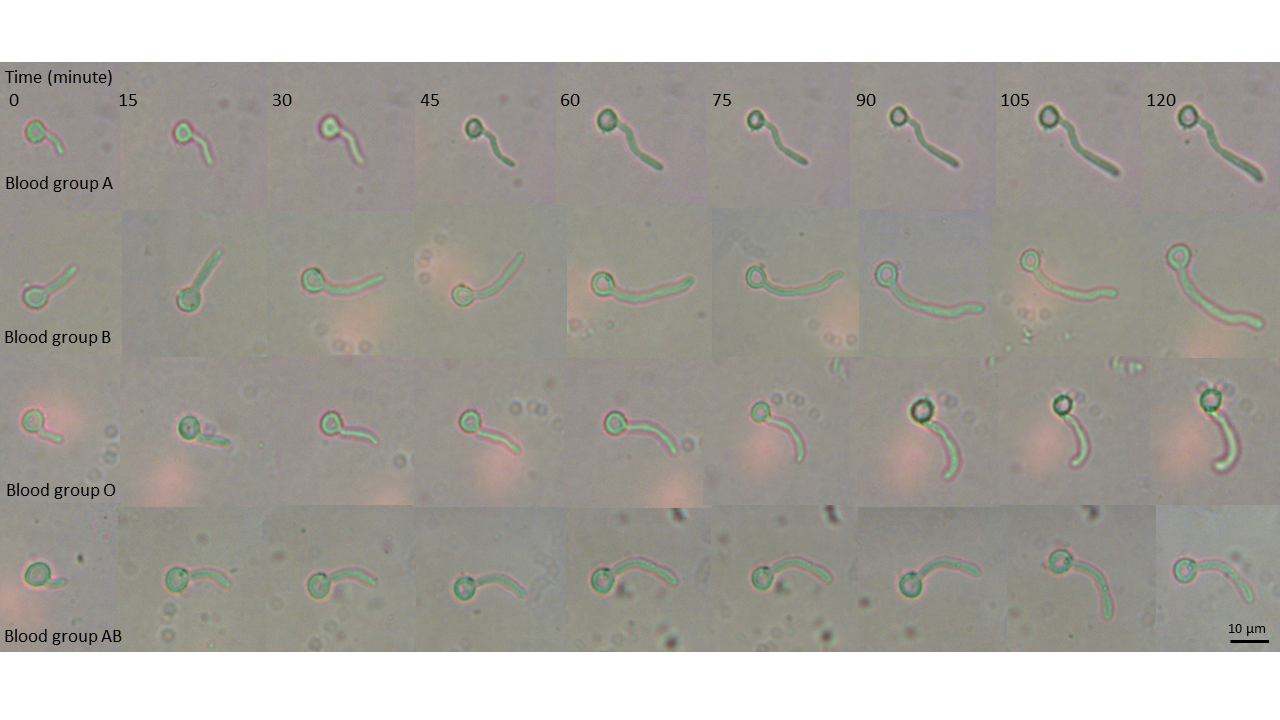The Potential Association of Human ABO Blood Group in Candida albicans Germination
DOI:
https://doi.org/10.48048/tis.2024.7116Keywords:
Germ tube, Candida spp., Candida albicans, Candidiasis, Candidemia, ABO blood group, YeastAbstract
Candidiasis is an infection caused by Candida spp., mostly Candida albicans. Infection with Candida spp. in immunocompetent individuals is often limited to the mouth, genital area or skin. However, patients who are immunocompromised due to infections or medications including corticosteroids or anticancer drugs are more susceptible to systemic candidiasis and candidemia. Upon C. albicans infections, the pathogenic yeasts enter the bloodstream and disseminate to the remote organs, leading to the formation of germ tube. Dimorphic adaptation is one of contributing virulent factors in C. albicans, which is responsible for disease pathogenesis and severity. However, little is known about whether differences among human ABO blood groups facilitate the development of C. albicans germ tube. Therefore, this study investigated the germ tube formation of C. albicans that grown in human serums from different ABO blood groups. Human pool serums varying ABO blood groups from healthy individuals were tested for C. albicans germ tube induction. After incubation for 2 h at 37 °C, the rate of germ tube formation at 15-min intervals was determined. Serum from human blood group A exhibited the highest rate of germ tube formation. Humans with blood group A exhibited the unique serum biochemical structure that possibly helps facilitate germ tube formation during C. albicans infection.
HIGHLIGHTS
- The association of blood groups of Thais to germination and invasion of Candida albicans were more common in Thai people.
- This research study focused on changes in Candida albicans germination related to the blood group.
- Human with blood group type A exhibited the highest rate of germ tube formation.
GRAPHICAL ABSTRACT
Downloads
Metrics
References
JA Hendrickson, C Hu, SL Aitken and N Beyda. Antifungal resistance: A concerning trend for the present and future. Curr. Infect. Dis. Rep. 2019; 21, 47.
R Prasad, R Nair and A Banerjee. Multidrug transporters of Candida species in clinical azole resistance. Fungal Genet. Biol. 2019; 132, 103252.
LN Silva, TPD Mello, LDS Ramos, MH Branquinha and ALSD Santos. New and promising chemotherapeutics for emerging infections involving drug-resistant non-albicans Candida species. Curr. Top. Med. Chem. 2019; 19, 2527-53.
A Pérez-Cantero, L López-Fernández, J Guarro and J Capilla. Azole resistance mechanisms in Aspergillus: Update and recent advances. Int. J. Antimicrob. Agents 2020; 55, 105807.
SK Shishodia, S Tiwari and J Shankar. Resistance mechanism and proteins in Aspergillus species against antifungal agents. Mycology 2019; 10, 151-65.
F Bongomin, S Gago, RO Oladele and DW Denning. Global and multi-national prevalence of fungal diseases-estimate precision. J. Fungi 2017; 3, 57.
F Khozeimeh, M Mohammadpour, M Taghian and V Naemy. A comparative study of Candida albicans mean colony counts and blood group antigens in the saliva of healthy subjects. Dent. Res. J. 2014; 11, 240-3.
S Jain, K Shigli, U Palekar, V Awinashe, A Jain and K Chiang. Association between oral candidiasis and ABO blood types. J. Appl. Dent. Med. Sci. 2016; 2, 30-7.
FR Vilani-Moreno, MSP Arruda, SG Claro, EVC Marcos and S Ura. Dermatophytosis: Association between ABO blood groups and reactivity to the trichophytin. Rev. Instituto Med. Trop. Sao Paulo 1999; 41, 285-9.
SA Balajee, T Menon and S Ranganathan. ABO blood groups in relation to the infection rate of dermatophytosis. Mycoses 1996; 39, 475-8.
PE Sudbery. The germ tubes of Candida albicans hyphae and pseudohyphae show different patterns of septin ring localization. Mol. Microbiol. 2001; 41, 19-31.
JP Lopes and MS Lionakis. Pathogenesis and virulence of Candida albicans. Virulence 2022; 13, 89-121.
American Diabetes Association. 2. Classification and diagnosis of diabetes: Standards of medical care in diabetes - 2021. Diabetes Care 2021; 44, S15-S33.
A Mujahid and FL Dickert. Blood group typing: From classical strategies to the application of synthetic antibodies generated by molecular imprinting. Sensors 2015; 16, 51.
EL Berkow, SR Lockhart and L Ostrosky-Zeichner. Antifungal susceptibility testing: Current approaches. Clin. Microbiol. Rev. 2020; 33, e00069-19.
University of Oregon. Calculating growth rates, Available at: https://pages.uoregon.edu/rgp/PPPM613/class8a.htm, accessed May 2023.
RA Arkowitz and M Bassilana. Recent advances in understanding Candida albicans hyphal growth. F1000Res 2019; 8, 700.
DR Ewald and SCJ Sumner. Blood type biochemistry and human disease. Wiley Interdiscipl. Rev. Syst. Biol. Med. 2016; 8, 517-35.
BJ Cameron and LJ Douglas. Blood group glycolipids as epithelial cell receptors for Candida albicans. Infect. Immun. 1996; 64, 891-6.
Y Imanishi, K Yokoyama and K Nishimura. Inductions of germ tube and hyphal formations are controlled by mRNA synthesis inhibitor in Candida albicans. Nippon Ishinkin Gakkai Zasshi 2004; 45, 113-9.
A Weiner, F Orange, S Lacas‐Gervais, K Rechav, V Ghugtyal, M Bassilana and RA Arkowitz. On-site secretory vesicle delivery drives filamentous growth in the fungal pathogen Candida albicans. Cell. Microbiol. 2019; 21, e12963.
AT Hendry and A Bakerspigel. Factors affecting serum inhibited growth of Candida albicans and Cryptococcus neoformans. Sabouraudia 1969; 7, 219-29.
WM Artis, TR Wade and HE Jones. Restoration of Trichophyton mentagrophytes growth in medium depleted of metals by chelation: Importance of iron. Sabouraudia 1983; 21, 41-8.

Downloads
Published
How to Cite
Issue
Section
License
Copyright (c) 2023 Walailak University

This work is licensed under a Creative Commons Attribution-NonCommercial-NoDerivatives 4.0 International License.






